
What Your Future Self Can Teach You
For much of the past decade, firms have been trying various ways to convince people to think about the future, and in particular about the people they will become.
What Your Future Self Can Teach YouRemember your New Year’s resolutions? Every January, many of us resolve to diet, exercise, turn off the television, and live life to its fullest. Research suggests that by this point in the year, most of us have failed. University of Scranton’s John C. Norcross has found that after three months, half of people who made resolutions haven’t been successful at sticking with them. And Richard Wiseman at the University of Hertfordshire established that by the end of a year, only 12 percent of resolutions were met.
The problem with big resolutions is that motivation tends to wane over time, says Chicago Booth’s Ayelet Fishbach, who studies motivation and decision making. People start out strong, but then reality sets in as they realize it’s easier to set goals than to carry them out. “The problem with persisting is that our priorities change in the course of a day, a week, a year,” says Fishbach. We may wake up in the morning determined to watch what we eat, but by the afternoon, we’re distracted—and start snacking again. Or we may feel determined to invest more time in relationships, but that slips our mind when an important work deadline looms. “Successful goal pursuit,” she says, “requires employing strategies that keep us on track as our priorities momentarily shift away.”
Research by Fishbach and others can help people salvage failed goals, or achieve new ones. Findings from behavioral science suggest that people can do better if they conceptualize goals more effectively, design incentives to boost rather than quash motivation, and use relationships with others strategically. With data-based maxims, you can move past failure and do a better job at achieving your goals.
Every endeavor has a starting point and an end point, which can be as specific as meeting a work deadline in one week or as general as losing weight. One reason many people fail to reach their objectives, says Fishbach, is that they tend to set goals that are difficult or even impossible to achieve, or too general. Making them more concrete and achievable—goals you can envision yourself completing—may yield better results.
Yet effective targets should be ambitious. As long as the goal is within reach, the more you expect from yourself, the more you’ll achieve, as people often respond to a challenge by working harder.
Fishbach and her former student, Ying Zhang of Peking University, performed a study in which they gave groups of participants an anagram task. Participants were asked to make new words from a target word. (For instance, from “seat” one can make “east,” “teas,” and “eats.”) But for some of the trials, there were no correct solutions, which allowed Fishbach and Zhang to gauge how much people would persist in the face of difficulty.
The researchers find that people who expected the task to be challenging stated more ambitious goals, saying in advance that they’d do better than two-thirds of the participants—and they persisted at the task for longer than others (almost eight minutes). People who expected the task to be less challenging stated they’d do about average on the task, and they persisted for just six minutes.
“Instead of an annual goal, set a monthly goal. Instead of weekly, make it daily."
Predictions can help motivate you
People who set a goal in the face of a difficult task spent more time trying to complete the task.
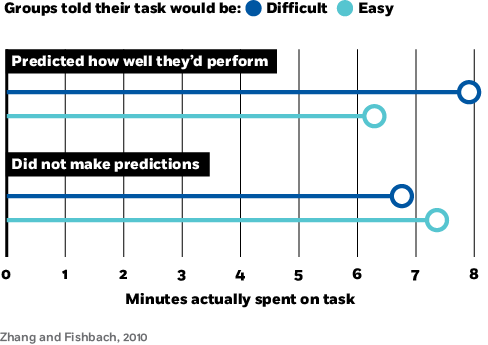
“Goals need to be self-imposed and optimistic,” says Fishbach. “People can motivate themselves by planning to finish a task earlier than later, or achieve a higher score, and so on. They might not meet the target, but the optimistic target is nonetheless more motivating than a pessimistic target. Just make sure the optimistic target is not an impossible target.”
Sometimes targets start as predictions—for example, if you tell a friend you think you’ll lose 5 pounds by June, that prediction ends up also functioning as a goal. Those predictions can help motivate you—just don’t worry too much about whether your prediction was actually correct; such worrying about accuracy may cause you to set too low a bar for yourself.
In another study, the same researchers asked people to complete a test at home. And they asked participants to predict how long it would take them to complete the test, which included 100 verbal and quantitative-reasoning questions.
Participants’ answers varied according to how much they thought the accuracy of their predictions mattered. Taking the pressure off in terms of accuracy seemed to help people set ambitious goals and work harder: told accuracy didn’t matter, participants predicted they’d finish a hard test more quickly than an easy test, and did just that. But when told that accuracy did matter, people predicted they’d need more time when the test was harder, and then took more time on a harder test.
Motivation waxes and wanes as you work on a particular goal. You start off motivated, and you are motivated again toward the end of a project. But in the middle stretch, your motivation tends to lag, data suggest.
Fishbach and her former student, Northwestern University’s Maferima Touré-Tillery, observed this across a series of tasks. In one experiment, which involved 10 trials, they asked participants to proofread passages for spelling and grammatical errors, and they had participants determine the length of those passages by coin flips. The results conformed to chance at the beginning and end of the tasks, where participants assigned themselves to read short passages about half the time, as would be expected by random coin flips. But in the middle, participants assigned themselves to short passages 70 percent of the time, suggesting that they probably assisted the flipping process—cheated—in the middle section.
Similarly, when the researchers recorded how observant Jews lit candles throughout the eight-day holiday of Chanukah, they saw people lag in the middle of the task. On the first night, 79 percent of the 202 people they observed reported lighting candles, but that dropped to 49 percent by the fifth night, before rebounding to 57 percent on the final night. And the more observant the participants were, the more likely they were to light candles at the beginning and end of the festival, “but behaved like less religious participants in the middle,” the researchers write.
Your motivation can lag along the way
Participants in a study started relatively strong, cut corners in the middle of the process, and focused once again toward the end.
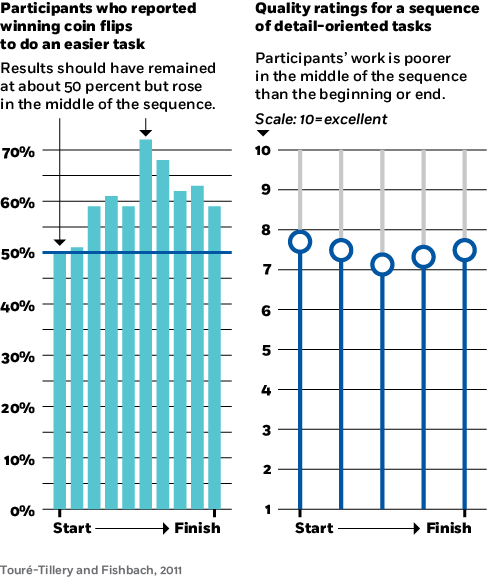
Fishbach and Touré-Tillery saw the same pattern when they asked people to cut out a series of shapes. “The participants did a better job on the first and last shapes—where they were literally cutting corners—and worse in the middle,” says Fishbach. “This is telling. The beginning and end of a project tend to be motivating.” We identify with our own actions more at the beginning and end of tasks, the researchers say. We see the middle stretch as less indicative of who we really are. So to motivate yourself in the middle of a task, minimize the amount of time you spend there by deconstructing your end goal. “Break a goal into shorter subgoals to maximize beginnings and ends, and to minimize middles,” says Fishbach. “Instead of an annual goal, set a monthly goal. Instead of weekly, make it daily.”
Work by Washington University’s Hengchen Dai and University of Pennsylvania’s Katherine L. Milkman and Jason Riis suggests that how we time our goal pursuit may also help us stay motivated. Making a goal on a landmark day—such as New Year’s Day or even just a Monday—is more motivating than beginning it on a regular day, they suggest. People are more likely to visit gyms on Mondays or to start working toward goals on the first day of spring, a phenomenon the researchers dub “the fresh start effect.” The fresh start represents a break from our former ways, as the researchers also find that it distances us psychologically from our past selves and failed attempts.
That’s why it can help to construct a goal out of smaller subgoals. With each step forward, we can feel as though we’re advancing toward future successes and away from past failures. Reach your annual goal by setting monthly markers along the way. To reach your goal for the week, outline daily tasks. And if you can’t even remember your resolutions for 2017, that’s OK—set a goal for this month, and create milestones for each week.
People are more motivated, and tend to move faster, when the end is in sight. This phenomenon is known as the goal gradient. Say you’re trying to run 5 miles: each increment of progress you make initially seems small, because that first mile you run represents just 20 percent of your total goal. Meanwhile the last mile you run completes the goal, so it feels more substantial.
This insight comes originally from academic research into animal behavior, including studies of rats in a maze, says Chicago Booth’s Oleg Urminsky. “Proximity to the goal increases motivation. If you’re a rat in a maze, you run faster the closer you get to the end. So we tested this in people, in the context of a loyalty program in coffee shops.”
When Urminsky was a doctoral student at Columbia University, he and his advisor, Ran Kivetz, and Yuhuang Zheng, now of Tsinghua University, demonstrated this phenomenon in coffeehouses on an urban college campus. The team gave people cards to be stamped each time they bought a cup of coffee.
Focus on what you’ve accomplished
Seeking an approach that would bring sushi restaurant customers back sooner, researchers find that initial progress was a factor.
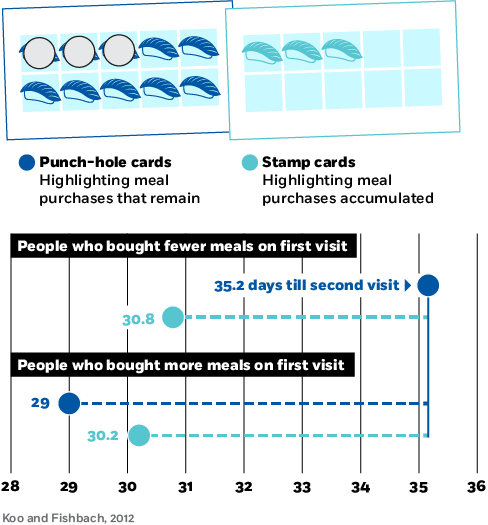
People bought coffee more frequently the closer they got to earning a free cup, the researchers observed. “The closer you are to the reward, the more likely you are to pursue it,” says Urminsky.
Later, Urminsky and his colleagues tested out two types of loyalty cards. Half the cards were numbered from 1 to 10, as before. In the other, “accelerated” group, the cards were numbered from 1 to 12 but had two of those slots already prestamped. People in the accelerated group completed their purchases an average of three days sooner, thanks to an illusion of progress. If you feel like you’re already two stamps closer to the end point, you’re more motivated to get there.
This same idea can get you more than free coffee. “Be aware of the fact that when the goal is far away, it’s going to seem harder,” says Urminsky. “So people should supplement with other methods earlier on.” For example, if your goal is to exercise more, consider starting out by exercising with a buddy, as social pressure is another motivating factor that will get you to the gym. (More on social pressure later.)
And make sure to take stock of what you’ve done, especially when you’re just starting out—measuring early progress at the beginning can be as motivating as using a goal that’s in sight at the end to spur you to the finish line. Using a similar setup to Urminsky’s, Fishbach, along with Minjung Koo of Sungkyunkwan University in Seoul, Korea, created stamp cards for a sushi restaurant, designing them to draw attention either to what had been accomplished or to what was left to do. The researchers measured how frequently the people using these stamp cards returned to the restaurant.
Connecting with our future selves can help us make wiser decisions in the present, from saving money to cutting calories.
“Near the beginning, people are motivated by what’s been done,” says Fishbach. In the restaurant study, people who had eaten just a few meals at the restaurant were motivated by what they had accomplished to earn the reward (a free meal). People who had eaten there a lot were motivated by the diminishing number they had left to eat. Fishbach and Koo call this the “small-area hypothesis,” indicating that we’re motivated by whatever is the smallest amount of progress, done or left to do.
Others of Fishbach’s studies have found that one’s commitment to a project also follows the same pattern. People who are not so committed or who are new to a pursuit (for instance, new employees) are also more motivated by what they’ve done already. But those who are highly committed to a pursuit or who are experienced at a project will be more motivated by what’s left to do.
So at the start of a goal, keep your mind on what you have done, even if it’s very small, Fishbach advises. “If it’s your first month in gym, well, you’ve already signed up; you’re already here,” she says. “Employees at a new job—you’ve already applied for, interviewed, and gotten the job. There’s always something that you’ve done.”
One way to change your behavior in the present is to think about the future. Urminsky and his Chicago Booth colleague Daniel Bartels find that connecting with our future selves can help us make wiser decisions in the present, from saving money to cutting calories.
Urminsky and Bartels have been studying people’s present and future selves for years and continue to make discoveries. In previous research, they demonstrated that people vary in how connected they are to their future selves, and that degree of connection can be manipulated to nudge people to make different purchasing decisions—be that to save more money or to give more to charity.
In a recent pair of studies, they extend this line of thought to show how people’s connections to their future selves can also be used to influence their choices affecting their health, including what they choose to eat and whether they go to the gym. The researchers interviewed University of Chicago students to measure how connected they were to their future selves. Students who were more connected to their future selves were more fit, as measured by Body-Mass Index, on average. Even among overweight students, those who were more connected to their future selves went to the campus gym more often.
It’s really important for you to enjoy your resolution. That’s not how most people choose their goals—they choose ones they feel are important.
The researchers also tested whether manipulating connectedness would affect snack choices among museum visitors. The team manipulated how connected people would feel to their future selves by having them read about studies that argue the self is either stable or changing over time, and included a subtle reminder to think about the potential for regrets from unhealthy eating. The participants chose between taking a high-calorie or low-calorie snack (or no snack) as compensation for participating. Among overweight participants, those who read about how the self is stable and were reminded to think about potential snacking regrets took fewer calories. However, if participants weren’t overweight, or weren’t reminded to think about snacking regrets, shifting their connectedness made no difference. So connectedness doesn’t necessarily help us remember our goals, but when we are conflicted, it helps us stick to them.
Some people love running for the sake of running. This type of runner has intrinsic motivation—they find running enjoyable. For others, a jog in a park may be more of an exercise in pain and torture, but they do it anyway because they feel they should, to stay in shape or lose weight. Their motivation is extrinsic. Research suggests we should harness the power of intrinsic motivation, as it can be the more powerful predictor of future success.
Find what intrinsically motivates you
Participation in a math task jumped when incentives were offered, and returned to normal levels shortly afterward.
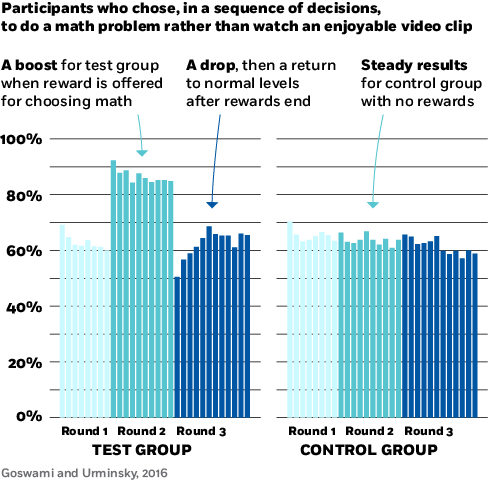
Fishbach and Booth PhD candidate Kaitlin Woolley asked people to think about their New Year’s resolutions and to rate how much they enjoyed them. For instance, the researchers asked if the resolution a person had selected was “something that provides you with a positive experience.” And was that resolution “important for you to do?” Two months later, they had people come back and report how well they’d stuck to their resolutions, and how well they expected to stick to them for the remainder of the year.
They learned it’s really important for you to enjoy your resolution. That’s not how people typically choose their goals—they choose ones they feel are important. Fishbach says it’s fine to go ahead and set goals that feel important, but don’t compromise on pleasure entirely. “Don’t choose a New Year’s resolution you don’t enjoy doing.” You’ll be setting yourself up for failure.
So forget about doing something you hate but think is important. Instead, if you’re trying to eat more healthy foods, don’t expect to learn to like all healthy foods—find some you already like. Find an exercise you enjoy. Find books you like reading. Tap into your intrinsic motivation.
Economists know well that incentives can be used to motivate people. But incentives have a reputation for killing off the very motivation you want to harness.
“The conventional wisdom in psychology for the last 20 years or so has been that incentives undermine intrinsic motivation,” says Urminsky. For instance, paying people to do a task they already love can sap their joy and make them less likely to do it when not paid to do so. “The policy conclusion is that it is dangerous to pay incentives for things that people might do without an incentive.”
What’s the best way to design incentives?
If you want to help someone reach a goal, pay them to do it: that’s the simple view of incentives. But research is helping to develop a more nuanced understanding.
Chicago Booth’s Devin G. Pope and University of California, Berkeley’s Stefano DellaVigna looked at how different incentives affected people’s performance on a short but tedious task: pressing the A and B buttons on a computer keyboard. The researchers presented 10,000 participants with a task—to press the buttons as many times as they could in 10 minutes—as well as one of 18 incentives, such as money or a donation to the Red Cross.
Looking at how each incentive affected the participants’ work, the researchers find that offering money worked best, but other incentives also proved effective—including telling people they would see their performance compared to others’ at the end of the task.
“In our context, we find that financial incentives are the most effective at motivating behavior,” says Pope. “However, we also find smaller but real benefits from nonfinancial motivators. While these nonfinancial incentives are not as effective overall, they are cost effective, given that they do not cost money to implement.”
Chicago Booth’s Sanjog Misra has looked at how data from employee performance can be used to understand individual patterns, and, in turn, help optimize how incentives are designed. Misra finds that certain circumstances cause performance to lag—for example, if an employee is far from meeting her quota, or close to the cap of a reward.
“Employees learn quickly about the incentive systems and the best way to make the most with the least amount of effort,” says Misra. “Sometimes incentive systems—for example, goals, quotas, or targets with incentives tied to them—can create distortions in effort. For example, if the quota is too high, employees may give up. If they have achieved the quota, and there are no incremental incentives, they can stop working.”
Misra’s work suggests that to maximize motivation, incentives should be based on the behavior patterns of the individual worker. It can be costly but nonetheless worthwhile to calculate each employee’s optimal incentive structure, says Misra.
Another way to boost effort is to implement systems that are flexible in both how and when incentives are awarded. “Good incentive systems allow employees to find the right part of the system that works for them,” says Misra. For example, a company with a rigid policy might offer a flat, 1.5 percent commission to all sales agents. But if there’s a sliding scale, some agents might be happy to work toward a 1 percent commission, while others might set higher goals and work harder to make 2 percent or more—and this might help the company retain more agents.
Misra says companies that are trying to design better incentive systems should keep the following in mind:
Incentives can backfire, and that’s particularly true for negative reinforcement—incentives that seek to punish rather than reward people.
A study by UC San Diego’s Uri Gneezy and University of Minnesota’s Aldo Rustichini asked owners of several Israeli childcare centers to fine parents who were late to pick up their kids, to test whether it would make parents more or less likely to arrive on time. More parents started picking up their children late—as the fine changed the social contract, the researchers surmised. As parents saw the fine as a payment for an extra service, it became acceptable to arrive late. Even when the fine was removed, parents still showed up late, which suggested that in some cases, an incentive (or here, a deterrent) can cause permanent change.
For more, read “Why your sales force needs smarter incentives,” from the Summer 2016 issue.
But Urminksy and his former PhD student, University of Buffalo’s Indranil Goswami, find that when an incentive is taken away, intrinsic motivation will come back, and fairly quickly. They offered participants money to encourage them to choose doing math puzzles over watching video clips, then looked at what happened once the incentive was taken away. Conventional wisdom was half-right: when the incentive disappeared, people initially did fewer puzzles. But the researchers saw the change was temporary. After a small break, motivation levels returned to what they were before an incentive was offered. Moreover, the more participants were paid, the less their intrinsic motivation was affected. People who were paid more demonstrated less need for a break.
There is some evidence that we can design effective rewards for ourselves. In a study, Milkman, Harvard’s Julia A. Minson, and University of Pennsylvania’s Kevin G. M. Volpp told some people they could only listen to “addictive” audio books—including The Hunger Games trilogy, The Da Vinci Code trilogy, the Twilight series, and The Devil Wears Prada—when they worked out at the gym. They gave others all-day access to the same audio books but encouraged them to use them only at the gym. A control group received $25 to spend at a bookstore. Initially, the first group visited the gym 51 percent more frequently than a control group, and the second group visited 29 percent more frequently, though these effects diminished over the course of a 9-week follow-up period.
The findings suggest that we may be able to create self-incentives by pairing undesirable activities with desirable ones. For those of us who need a little extra push, websites such as stickK.com, created by behavioral economists at Yale University, may offer assistance. The site provides a structured forum for users to set goals, establish stakes, and invite friends and family to hold them accountable.
Pressure from those around us can spur us on—having a running buddy or some friendly competition at the office tends to work in our favor. But social networks can actually slow us down, while a little old-fashioned competition may work much better.
Researchers at the University of Pennsylvania—led by Jingwen Zhang (now at UC Davis), with Devon Brackbill, Sijia Yang, Joshua Becker, Natalie Herbert, and senior author Damon Centola—looked at how active people were during an exercise initiative that included fitness classes, mentoring, and information about healthy eating. The researchers measured success by how many exercise classes people took over the course of an 11-week program.
Unbeknownst to the participants, the researchers had assigned them to one of four experimental groups, designed to test the effects of social influence on their behavior. The first group interacted on a website, where they could chat with and support one another, but not see others’ “scores”—the number of times they took an exercise class on their own during the 11 weeks. This showcased social networking but deemphasized competition. In the second group, individuals competed against each other, able to see how often others were exercising. In a third group, people competed in teams, and the scores of other teams were visible. Finally, in a fourth (control) group, people were given access to the same exercise program, but without any online social network, either supportive or competitive, to motivate them.
A little social pressure can spur you
While creating competitive environments motivated people in an exercise initiative, support groups created a sense of inertia.
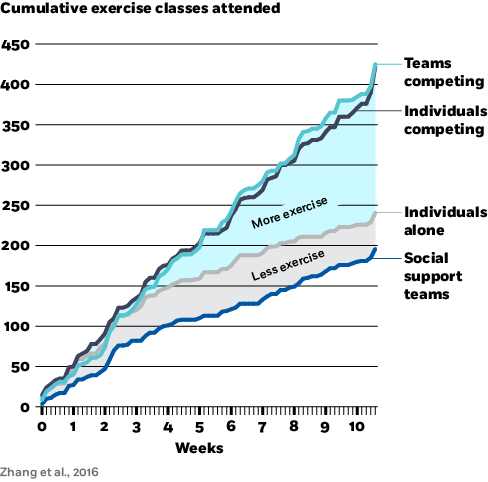
People who competed against others, either individually or as groups, took significantly more classes than anyone else—90 percent more than in the control group. Yet people who supported each other online took the fewest classes.
It would seem that encouragement is far less effective than good-old competition. “People [in the social support group] did not use their peers as sources of social comparison, but instead as sources of encouragement,” says Centola. “The least-active members of the group created a kind of social inertia that pulled the others to exercise less,” he says. However, when people could see others’ scores, they were motivated to work harder. “If we see others doing better—getting back into shape faster, going to more fitness classes, and losing weight more quickly—it gives us a new goal. Peer competition is very useful for goal setting, and for creating aspirations for getting into shape faster.”
And with competition, we lust after what other people want, not what they have. Fishbach and the University of Florida’s Yanping Tu looked at people’s tastes, from food to items on Amazon. They find that people often choose to make choices that complement but don’t overlap with their friends’ choices. For example, people would buy gum, as their friends had done, but choose different flavors. “Psychologically, people are probably in the mind-set, ‘I’m not buying the same thing as you. But if you like it, then I want to have it,’” says Fishbach.
Looked at together, these research findings can be prescriptive, and help you meet goals you’ve previously failed at. So forget about the person you were when you made your resolutions for 2017. Instead, set a new, optimistic goal that challenges what you think you can accomplish. Predict how you’ll do on it; write down the answer. Think about how your future self will feel when you accomplish it. Make sure your goal involves something you enjoy doing—if it doesn’t, go back and rethink the goal. After that, create realistic, weekly subgoals. Make the subgoals measurable, and reward yourself when you achieve them. Also give yourself a reward for starting this process, that’s akin to one free punch toward a free coffee.
Your Privacy
We want to demonstrate our commitment to your privacy. Please review Chicago Booth's privacy notice, which provides information explaining how and why we collect particular information when you visit our website.